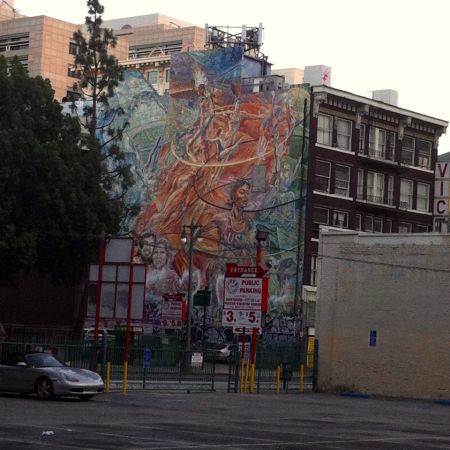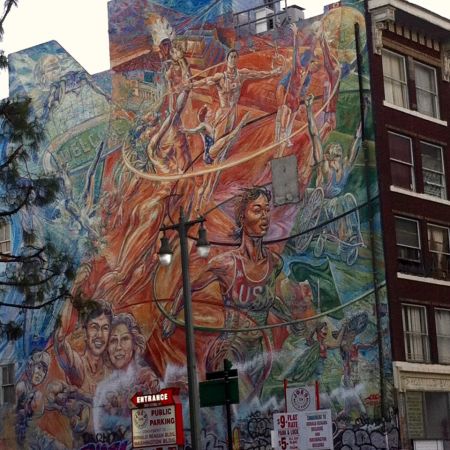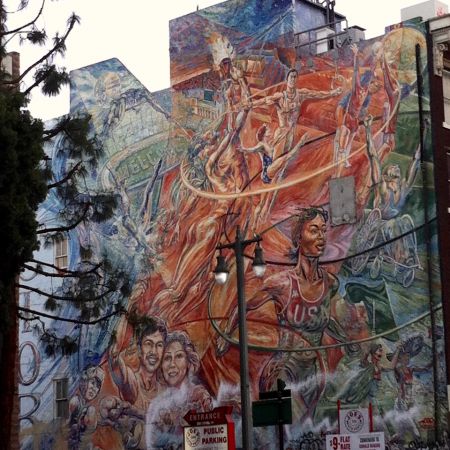242 S. Broadway Los Angeles, CA 90015
The title of the piece links the 52 years separating the 1932 and the 1984 Olympic Games held in Los Angeles, with an Aztec tradition in which all lights were extinguished every 52 years followed by igniting a new torch and restoring fire to the nation. This custom is represented at the top of the mural by Aztec warriors carrying torches.
"El Nuevo Fuego" contains a montage of large and small portraits of participants in the 1984 Summer Olympics, as well as symbolic images such as the broken pyramid and the number 8.1, memorializing the 1985 Mexico City earthquake. In response to Broadway's predominantly Hispanic and Black population, Gold Medal winner boxer Paul Gonzales from East Los Angeles, track-star Valerie Brisco-Hooks from Los Angeles, and Mexico's championship walker Ernesto Canto are prominently displayed and placed close to the street. Other Olympic winners depicted in the mural are Koji Gushican (gymnastics), Greg Luganis (diving) and Pierre Vignon (pole vault).(1)The wheelchair bound person refers to the Special Olympics, and fighters in the foreground refer to the Golden Gloves, which were not Olympic events.
Ramona Morin, mother of David Morin who assisted in executing the mural, died while the mural was being completed and is memorialized in the bouquet of flowers. The names of children born to people involved in the mural are also recognized, including Roberto Grigas, son of Bob Grigas, an assistant on the mural, and Benjamin Botello, son of David Botello, one of the two artists making up East Los Streetscapers.
Paul Harter, the owner of Victor Clothing, insisted that the mural serve as an advertisement for his store and wanted "Victor Clothing" prominently displayed at the top of the mural. The artists pointed out that the unevenness of the building's roofline prevented this and persuaded Harter to move his advertisement to the side. They also succeeded in minimizing the sign's impact by blending the colors of the lettering into their mural and into Kent Twitchell's adjacent "Bride and Groom".
As part of the arts festival held in conjunction with the 1984 Olympic Games in Los Angeles, ten murals were commissioned for retaining walls along freeways leading to the Coliseum. The East Los Streetscapers submitted a proposal based on a 9' x 10' portable mural they executed for the 1982 Los Angeles Streetscene, but it was not accepted. They then submitted a modified design to Harter, who was hiring Latino muralists to paint advertisements for his store on the building's exterior. Harter rejected the East Los Streetscapers' first design, but within a month after the end of the 1984 Olympics, he accepted a new design that included Olympic gold-medal winners.
It took nine months to finalize the mural's design. In developing the design, Healy and Botello first agreed on ideas to be presented. They each prepared sketches and critiqued them. As with their other murals, Wayne Healy was primarily responsible for form and composition while Dave Botello was primarily responsible for color. Botello chose intense colors because they are part of the culture of the Broadway shoppers and he felt the colors had to compete with the surrounding signage. While the mural was executed, changes were made to the original design, including the removal of a nude Aztec and the singer Vicky Carr and adding the person in a wheelchair.(2)
A cartoon of the final design was prepared and divided into sections by a grid. Each section was projected by an opaque projector on 4' x 6' paper. The lines within each section of the grid were traced on the paper and holes were punched along the lines with an electric perforator. The sheets were then attached to the wall on which the mural was to be painted. Bags of chalk were pounded on the sheets, leaving the lines of the mural on the building's wall. These lines were quickly painted so they would not wash away.(3) East Los Streetscapers used an acrylic paint from a local company called Nova Color.(4)
This information was provided by Michael Several, Los Angeles, February 1999.
(1) "The Painting of El Nuevo Fuego," by Pablo Xap, Community Murals Magazine, Spring, 1987, p.17
(2) "Great Mural a Belated Monument to the Games," Los Angeles Times, February 22, 1985, Pt. V, p.2
(3) Interview with David Botello by Michael Several, November 19, 1987
(4) Interview with David Botello by Michael Several, December 3, 1987
All photos: © Isabel Rojas-Williams





